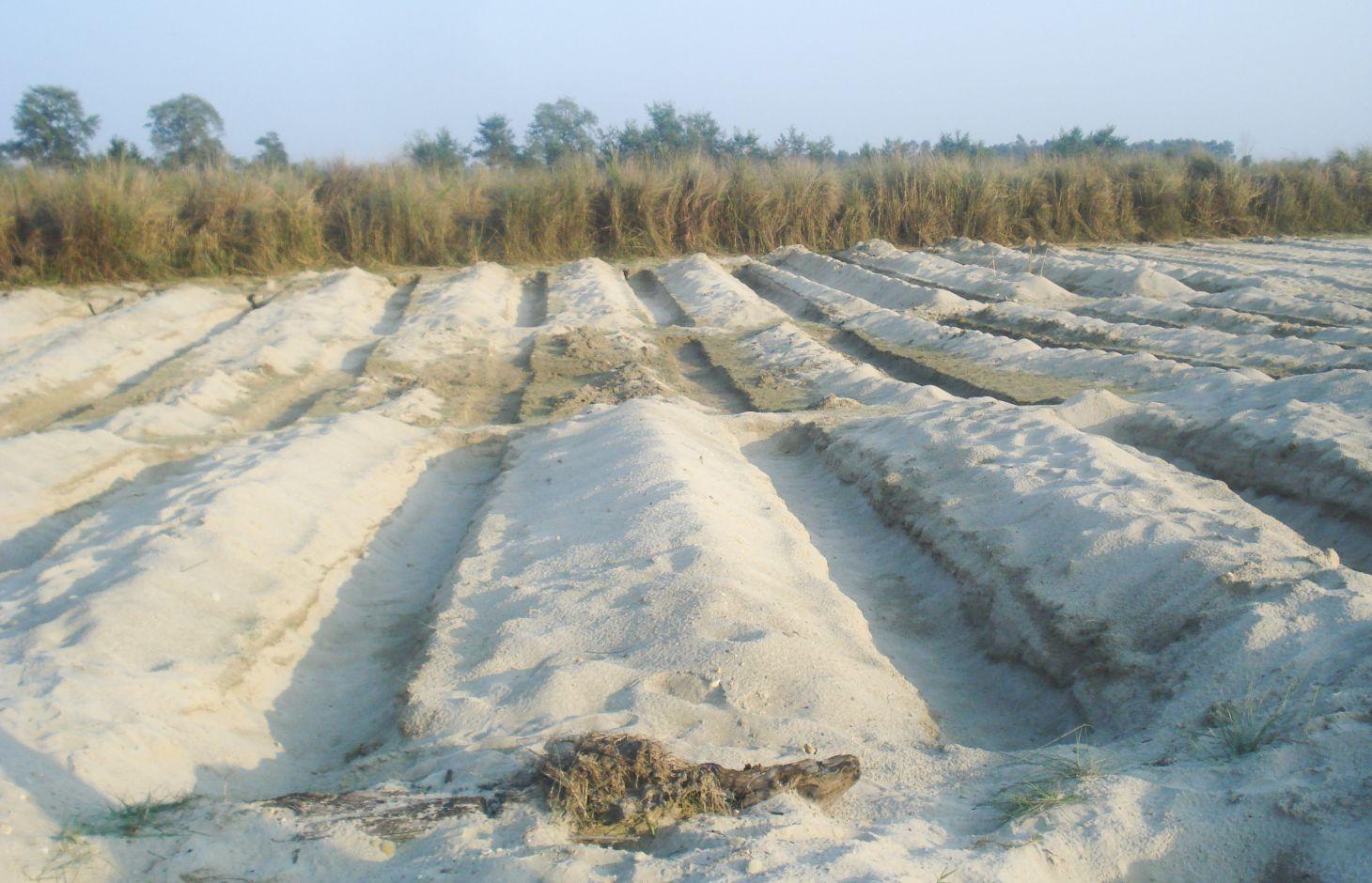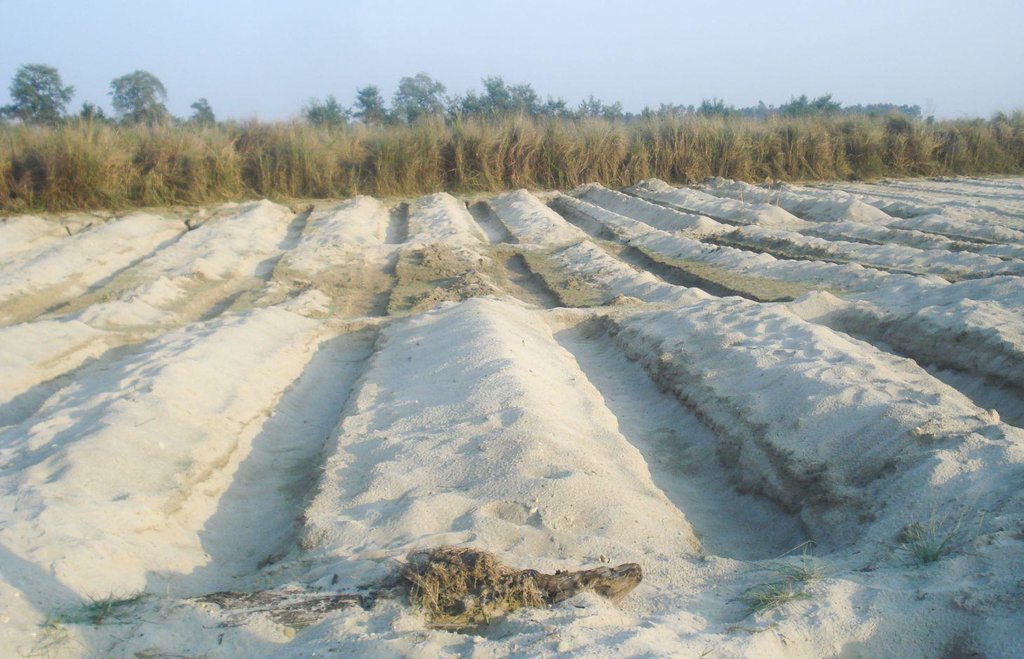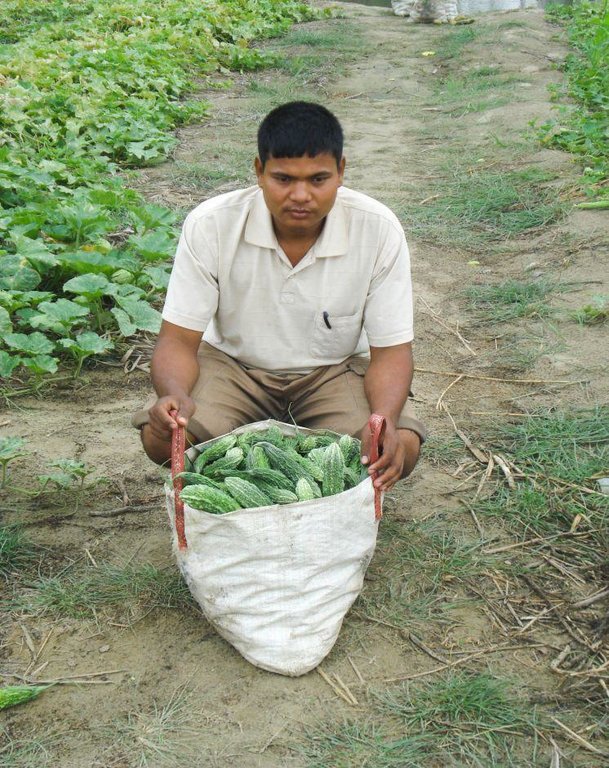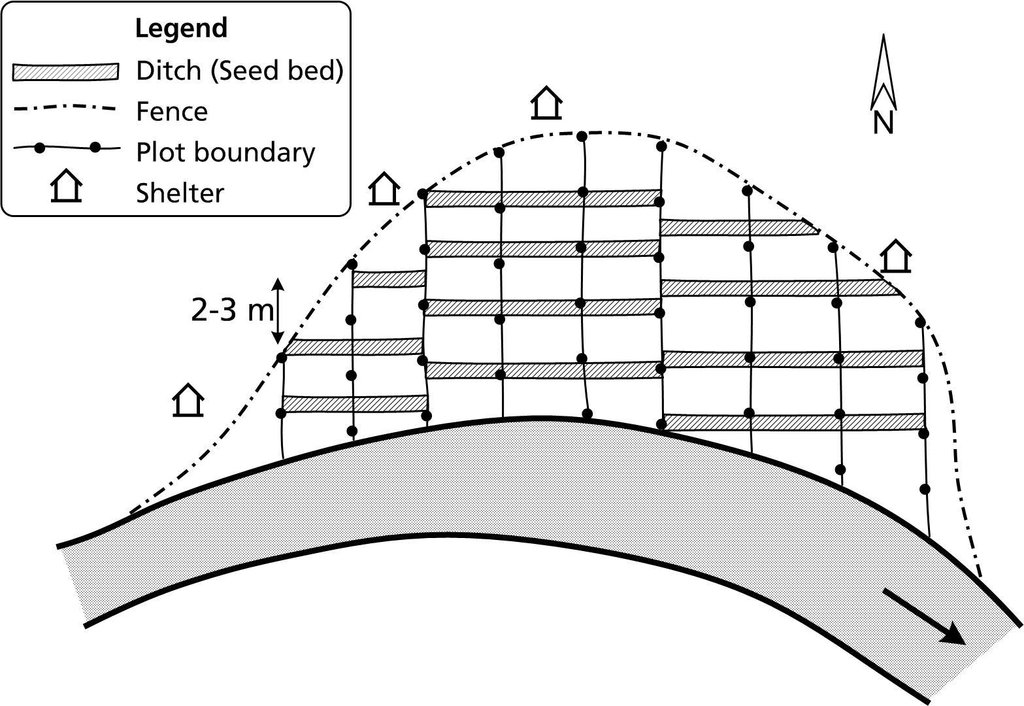Riverbed farming [尼泊尔]
- 创建:
- 更新:
- 编制者: Shreedip Sigdel
- 编辑者: –
- 审查者: David Streiff, Alexandra Gavilano
Bagar Kheti (Main Contributors: Elam Plus and Hari Gurung, Helvetas Nepal)
technologies_1691 - 尼泊尔
查看章节
全部展开 全部收起1. 一般信息
1.2 参与该技术评估和文件编制的资源人员和机构的联系方式
SLM专业人员:
Plus Elam
Helvetas
SLM专业人员:
Gurung Hari
Helvetas Nepal
尼泊尔
SLM专业人员:
Merz Juerg
Helvetas Nepal
瑞士
有助于对技术进行记录/评估的机构名称(如相关)
ICIMOD International Centre for Integrated Mountain Development (ICIMOD) - 尼泊尔有助于对技术进行记录/评估的机构名称(如相关)
HELVETAS (Swiss Intercooperation)1.3 关于使用通过WOCAT记录的数据的条件
编制者和关键资源人员接受有关使用通过WOCAT记录数据的条件。:
是
1.5 参考关于SLM方法(使用WOCAT记录的SLM方法)的调查问卷
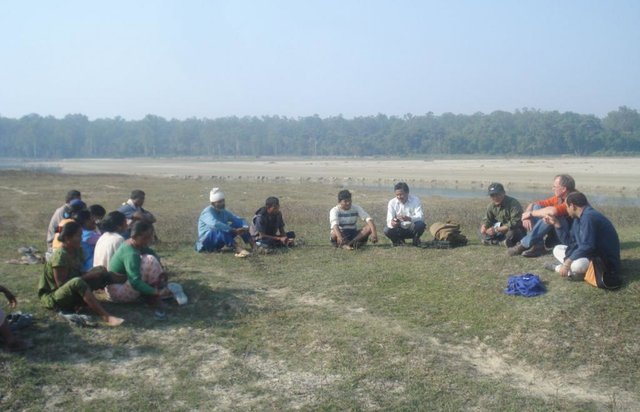
Land distribution and allocation for riverbed farming [尼泊尔]
Riverbed farming provides landless and land-poor households with the possibility to earn an income from on-farm activities close to home
- 编制者: Shreedip Sigdel
2. SLM技术的说明
2.1 技术简介
技术定义:
Riverbed farming can be used to increase household income and to improve the food security of landless and land-poor households in the Terai area of Nepal.
2.2 技术的详细说明
说明:
It is estimated that about 8,000 hectares of riverbed land would be suitable for agricultural cultivation in the Kailali and Kanchanpur Districts in the Western Terai areas of Nepal. After the river water recedes in the post-monsoon season, vegetables are planted in ditches dug into the seasonal sand banks; the crops are harvested before the onset of the next monsoon. In 2006, Elam Plus of HELVETAS Swiss Inter-cooperation Nepal, assessed local practices of riverbed farming and piloted an improved approach with 670 farmers, mostly from the indigenous Tharu community. During the first year they cultivated 43 hectares. Since the initial results indicated that riverbed farming could increase the target population’s income significantly, the programme was expanded from the initial two districts (Kailali and Kanchanpur) to two new districts (Banke, and Bardiya). The number of households was increased to 2000 in 2008 and 3165 in 2012 after the initiative won a Global Development Market Place award from the World Bank.
Establishment / maintenance activities and inputs: Requirements for riverbed farming:
• On average, the water table should not be lower than 1 m; when the water table is lower than this, too much labour is required.
• Plots are allocated perpendicular to the river flow in order to give each farmer access to a variety of land types (and moisture levels) suitable for different crops.
• Ditches are up to 1 m deep and 1 m wide. The length depends on how much land is available.
• A row-to-row spacing of 2–3 m (between the ditches) and plant-to-plant spacing of 0.5–1 m is required depending on the crop.
• The ditches are dug in an east-west orientation to maximize the amount of sunshine they receive and to minimise the collection of sand carried by the prevailing winds.
• Riverbed farmers can build shelters close to their plots so that they can be close at hand to fend off thieves and wild animals.
2.3 技术照片
2.5 已应用该技术的、本评估所涵盖的国家/地区/地点
国家:
尼泊尔
有关地点的进一步说明:
Kanchanpur, Kailali Districts
具体说明该技术的分布:
- 均匀地分布在一个区域
如果技术均匀分布在一个区域,则指定覆盖的区域(单位为平方千米):
4.0
注释:
Total area covered by the SLM Technology is 4 km2.
2.7 技术介绍
详细说明该技术是如何引入的:
- 通过项目/外部干预
3. SLM技术的分类
3.1 该技术的主要目的
- 创造有益的经济影响
- 创造有益的社会影响
3.2 应用该技术的当前土地利用类型

农田
- 一年一作
年作 - 具体指明作物:
- 蔬菜 - 其他
每年的生长季节数:
- 1
具体说明:
Longest growing period from month to month: November to May
注释:
Major land use problems (compiler’s opinion): Rivers in the Terai region change their course frequently and when they do, the adjacent lands are flooded. The riverbeds are flooded annually, while the riverbanks are only flooded during extreme events. The annually flooded riverbeds are seasonally dry (from September to May) and are a generally unused land resource. Landless and land- poor farmers can use this land to cultivate seasonal vegetables that are adapted to the environmental conditions prevalent on riverbeds.
3.5 该技术所属的SLM组
- 改良的地面/植被覆盖
- use different type of land for cultivation
3.6 包含该技术的可持续土地管理措施

农艺措施
- A2:有机质/土壤肥力

结构措施
- S3:分级沟渠、渠道、水道
3.7 该技术强调的主要土地退化类型

土壤水蚀
- Wr:河岸侵蚀
注释:
Main causes of degradation: floods
3.8 防止、减少或恢复土地退化
具体数量名该技术与土地退化有关的目标:
- 减少土地退化
4. 技术规范、实施活动、投入和成本
4.1 该技术的技术图纸
技术规范(与技术图纸相关):
Plots for riverbed farming are allocated perpendicular to the river flow and the ditches are dug in an east-west orientation.
Technical knowledge required for land users: moderate
Main technical functions: increase / maintain water stored in soil, Support Income Generation
Secondary technical functions: improvement of ground cover, increase in organic matter, Stabilizes the soil
作者:
J Merz, AK Thaku
4.2 有关投入和成本计算的一般信息
具体说明成本和投入是如何计算的:
- 每个技术区域
注明尺寸和面积单位:
ha
具体说明成本计算所用货币:
- 美元
4.3 技术建立活动
| 活动 | 时间(季度) | |
|---|---|---|
| 1. | Dig ditches in an east-west direction about 2 to 3 m apart. The ditches can be up to 1 m deep and 1 m wide; the length will depend on the shape of the land. | |
| 2. | Apply fertilizer: farmyard manure/compost about 12 tonnes; urea about 100 kg; di-ammonium phosphate (DAP) about 120 kg; and potash about 30 kg per ha. | |
| 3. | Plant seeds/seedlings using the appropriate row-to-row (RXR) and plant-to-plant (PXP) distance for at least one crop. A row-to-row distance of 3 m is required for bottle gourd, pumpkin, and water melon and 2 m for bitter gourd and cucumber; a plant-to-plant distance of 0.5 m is needed for cucumber and bitter gourd and 1 m for water melon, bottle gourd, and pumpkin. |
4.4 技术建立所需要的费用和投入
| 对投入进行具体说明 | 单位 | 数量 | 单位成本 | 每项投入的总成本 | 土地使用者承担的成本% | |
|---|---|---|---|---|---|---|
| 劳动力 | Dig ditches and applying fertilizer and manure | ha | 1.0 | 232.0 | 232.0 | 100.0 |
| 设备 | Sprayer, watering cans,spade | ha | 1.0 | 42.0 | 42.0 | |
| 肥料和杀菌剂 | Seeds, chemical fertilizer | ha | 1.0 | 267.0 | 267.0 | |
| 施工材料 | Plastic bags,mulching material | ha | 1.0 | 21.0 | 21.0 | |
| 技术建立所需总成本 | 562.0 | |||||
| 技术建立总成本,美元 | 562.0 | |||||
4.5 维护/经常性活动
| 活动 | 时间/频率 | |
|---|---|---|
| 1. | Water new plots every 2 to 3 days; as the seedlings mature, water weekly or as needed depending on the weather and the soilconditions. | |
| 2. | Replace seedlings that have died and replant seeds in places where they have not germinated | |
| 3. | Top dress with nitrogen, phosphorous, potassium | |
| 4. | Mulch with straw and grass | |
| 5. | Weed and protect plants as needed | |
| 6. | Protect the riverbed areas throughout the growing season as they are prone to attacks by thieves and wild animals, mainly jackals and monkeys. However, note that the reported losses to date have been very minimal. |
4.6 维护/经常性活动所需要的费用和投入(每年)
| 对投入进行具体说明 | 单位 | 数量 | 单位成本 | 每项投入的总成本 | 土地使用者承担的成本% | |
|---|---|---|---|---|---|---|
| 劳动力 | Maintaining plots | ha | 1.0 | 42.0 | 42.0 | 100.0 |
| 设备 | Sprayer, watering cans,spade | ha | 1.0 | 28.0 | 28.0 | 25.0 |
| 肥料和杀菌剂 | Seeds, chemical fertilizer | ha | 1.0 | 84.0 | 84.0 | 25.0 |
| 施工材料 | Plastic bags, mulching material | ha | 1.0 | 11.0 | 11.0 | 50.0 |
| 技术维护所需总成本 | 165.0 | |||||
| 技术维护总成本,美元 | 165.0 | |||||
4.7 影响成本的最重要因素
描述影响成本的最决定性因素:
All costs and amounts are rough estimates by the technicians and authors.
5. 自然和人文环境
5.1 气候
年降雨量
- < 250毫米
- 251-500毫米
- 501-750毫米
- 751-1,000毫米
- 1,001-1,500毫米
- 1,501-2,000毫米
- 2,001-3,000毫米
- 3,001-4,000毫米
- > 4,000毫米
农业气候带
- 潮湿的
Thermal climate class: subtropics
5.2 地形
平均坡度:
- 水平(0-2%)
- 缓降(3-5%)
- 平缓(6-10%)
- 滚坡(11-15%)
- 崎岖(16-30%)
- 陡峭(31-60%)
- 非常陡峭(>60%)
地形:
- 高原/平原
- 山脊
- 山坡
- 山地斜坡
- 麓坡
- 谷底
垂直分布带:
- 0-100 m a.s.l.
- 101-500 m a.s.l.
- 501-1,000 m a.s.l.
- 1,001-1,500 m a.s.l.
- 1,501-2,000 m a.s.l.
- 2,001-2,500 m a.s.l.
- 2,501-3,000 m a.s.l.
- 3,001-4,000 m a.s.l.
- > 4,000 m a.s.l.
5.3 土壤
平均土层深度:
- 非常浅(0-20厘米)
- 浅(21-50厘米)
- 中等深度(51-80厘米)
- 深(81-120厘米)
- 非常深(> 120厘米)
土壤质地(表土):
- 粗粒/轻(砂质)
表土有机质:
- 低(<1%)
如有可能,附上完整的土壤描述或具体说明可用的信息,例如土壤类型、土壤酸碱度、阳离子交换能力、氮、盐度等。:
Soil fertility is medium
Soil drainage / infiltration is good
Soil water storage capacity is low
5.4 水资源可用性和质量
地下水位表:
5-50米
地表水的可用性:
匮乏/没有
水质(未处理):
良好饮用水
关于水质和水量的注释和进一步规范:
Ground water table: 30-50 m
5.5 生物多样性
物种多样性:
- 低
5.6 应用该技术的土地使用者的特征
生产系统的市场定位:
- 混合(生计/商业)
非农收入:
- > 收入的50%
相对财富水平:
- 贫瘠
个人或集体:
- 个人/家庭
说明土地使用者的其他有关特征:
Population density: 200-500 persons/km2
5.7 应用该技术的土地使用者使用的平均土地面积
- < 0.5 公顷
- 0.5-1 公顷
- 1-2 公顷
- 2-5公顷
- 5-15公顷
- 15-50公顷
- 50-100公顷
- 100-500公顷
- 500-1,000公顷
- 1,000-10,000公顷
- > 10,000公顷
5.8 土地所有权、土地使用权和水使用权
- landless
5.9 进入服务和基础设施的通道
健康:
- 贫瘠
- 适度的
- 好
教育:
- 贫瘠
- 适度的
- 好
技术援助:
- 贫瘠
- 适度的
- 好
就业(例如非农):
- 贫瘠
- 适度的
- 好
市场:
- 贫瘠
- 适度的
- 好
能源:
- 贫瘠
- 适度的
- 好
道路和交通:
- 贫瘠
- 适度的
- 好
饮用水和卫生设施:
- 贫瘠
- 适度的
- 好
金融服务:
- 贫瘠
- 适度的
- 好
6. 影响和结论性说明
6.1 该技术的现场影响
社会经济效应
收入和成本
农业收入
收入来源的多样性
注释/具体说明:
Provides vegetables for riverbed farming households
其它社会经济效应
dependent on external agricultural inputs
社会文化影响
食品安全/自给自足
注释/具体说明:
Riverbed crops can be exchanged for food grain; on average,this can provide an additional four month
冲突缓解
注释/具体说明:
Conflicts can arise when the land is being allocated and border conflict can arise between different groups
社会经济弱势群体的情况
注释/具体说明:
Additional income can be used to cover school fees and health services
livelihood and human well-being
注释/具体说明:
Provides alternative means of income as well as food security for landless and land-poor households
social status of local resource persons
need for income usually met by migration and by off-farm daily wage labour
生态影响
水循环/径流
水质
注释/具体说明:
Excessive use of fertilizers may affect water quality and the use of pesticides in the case of massive pest invasions may affect the water quality as well
土壤
土壤覆盖层
土壤流失
注释/具体说明:
Minimize soil loss due to wind erosion
减少气候和灾害风险
洪水影响
注释/具体说明:
Crops can be lost during floods, cold spells and hailstormes
6.2 该技术的场外影响已经显现
Local availability of fresh vegetables
6.3 技术对渐变气候以及与气候相关的极端情况/灾害的暴露和敏感性(土地使用者认为的极端情况/灾害)
渐变气候
渐变气候
| 季节 | 增加或减少 | 该技术是如何应对的? | |
|---|---|---|---|
| 年温度 | 增加 | 好 |
气候有关的极端情况(灾害)
水文灾害
| 该技术是如何应对的? | |
|---|---|
| 比较和缓的(河道)洪水 | 不好 |
6.4 成本效益分析
技术收益与技术建立成本相比如何(从土地使用者的角度看)?
短期回报:
积极
长期回报:
积极
技术收益与技术维护成本/经常性成本相比如何(从土地使用者的角度看)?
短期回报:
积极
长期回报:
积极
6.5 技术采用
注释:
There is a moderate trend towards spontaneous adoption of the Technology
Comments on adoption trend: The majority of riverbed farmers among the first few groups to learn the technique continued riverbed farming after support for the project ended. In the third year, 55 of the original 61 groups were still farming on the riverbed even though they did not receive any agricultural inputs with the exception of support from the local resource persons. The local resource persons have organized themselves into an independent organisation that now provides technical support through the Micro Enterprise Development Fund and through individual channels. Now that Nepali farmers have started to farm the riverbeds in the Kailali and Kanchanpur Districts, the number of Indian farmers who previously farmed these riverbeds has drastically diminished.
6.7 该技术的优点/长处/机会
| 编制者或其他关键资源人员认为的长处/优势/机会 |
|---|
|
Riverbed farming provides a new source of income for landless and land-poor households How can they be sustained / enhanced? Continue to provide technical support through local resource persons. These persons can be supported through district-based instruments such as the Micro Enterprise Development Fund. Local governing bodies such as the district development committees, municipalities, and village development committees, can support riverbed farming with their own funds; can support farmers with the land leasing process, can help to identify primary stakeholders, and can also help by promoting policies that are favourable towards riverbed farming. |
|
Riverbed farming has a very high cost-benefit ratio and a very low investment requirement. How can they be sustained / enhanced? Continue to promote this technology among primary stakeholders. |
|
All services including the supply of quality seeds, tools, and materials are now processed through the local agrovets and agricultural extension is available through local resource persons. These are locally available and of high quality. How can they be sustained / enhanced? Agrovets, local resource persons, and their associations may need further capacity building through different channels such as the Micro Enterprise Development Fund, and/or the District Agricultural Development Office |
6.8 技术的弱点/缺点/风险及其克服方法
| 编制者或其他关键资源人员认为的弱点/缺点/风险 | 如何克服它们? |
|---|---|
| Competition from riverbed products originating in India and a glut during the season | Riverbed farmer groups need to improve their understanding of the value chain and their access to markets. |
| Mineral fertilizer and biopesticides are now used to ensure a good harvest | Promote sustainable soil management practices including the use of farmyard manure, urine collection, and bio-pesticides |
| Land ownership of riverbed land is often contested | Long term leasehold agreements need to be negotiated with land owners |
7. 参考和链接
7.1 信息的方法/来源
7.2 参考可用出版物
标题、作者、年份、ISBN:
Riverbed farming manual and local resource person training modules. Kathmandu, Nepal, HELVETAS Swiss Intercooperation Nepal
链接和模块
全部展开 全部收起链接

Land distribution and allocation for riverbed farming [尼泊尔]
Riverbed farming provides landless and land-poor households with the possibility to earn an income from on-farm activities close to home
- 编制者: Shreedip Sigdel
模块
无模块


